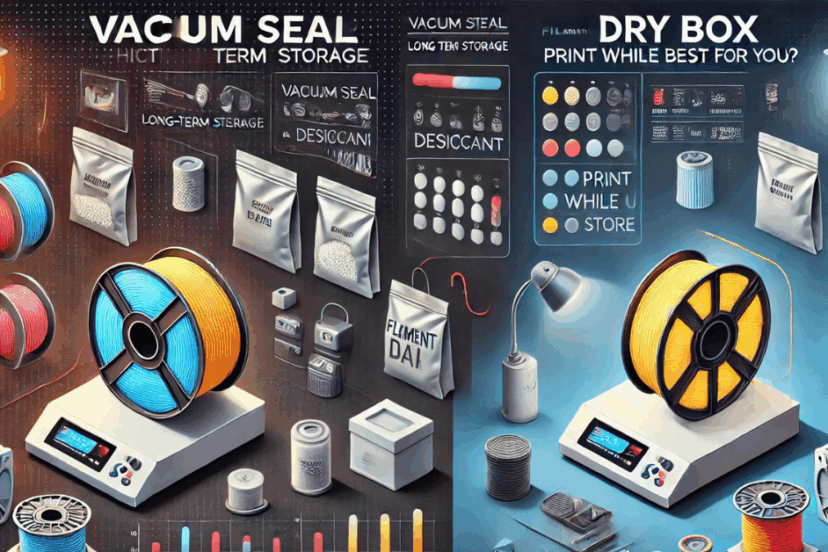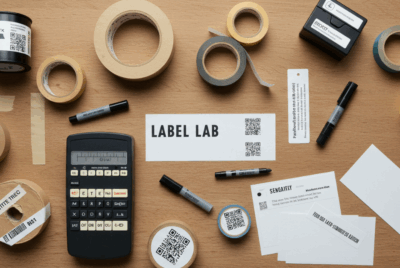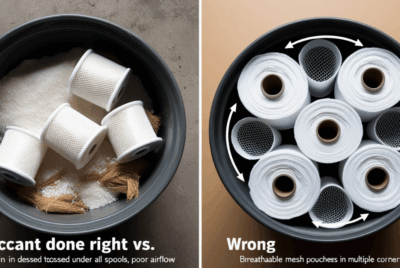What are the best storage containers for filament?
Choosing the right storage container for 3D filament is essential to maintaining its quality and preventing issues like moisture absorption, which can negatively affect print quality. The best storage containers for filament should provide protection from humidity, dust, and environmental damage while keeping the filament organized and easy to access. Below are some of the best storage containers for 3D filament:
1. Airtight Plastic Storage Bins
- Why It’s Great: Airtight plastic bins are affordable, readily available, and provide excellent protection against dust and moisture when used with desiccants or silica gel packets.
- Features:
- Sealed lids to prevent air and moisture from entering.
- Can hold multiple filament spools.
- Easy to stack for space efficiency.
- Best For: Short-term to medium-term storage of filament such as PLA, ABS, and PETG.
- Recommendation: Use along with silica gel packets to absorb any moisture.
2. Vacuum-Sealed Bags
- Why It’s Great: Vacuum-sealed bags remove air and reduce moisture exposure, making them one of the best options for long-term filament storage.
- Features:
- Vacuum sealing helps maintain a moisture-free environment.
- Desiccants can be added for extra moisture protection.
- Compact and space-efficient.
- Best For: Nylon, TPU, and other moisture-sensitive filaments.
- Recommendation: Use a vacuum sealer to tightly seal the bags and store them in a cool, dry place.
3. Filament Dry Box
- Why It’s Great: Filament dry boxes are designed to keep filament at optimal humidity levels by using built-in desiccants or a heating element to remove moisture.
- Features:
- Humidity control to keep filament dry.
- Can store a single spool or multiple spools.
- Some models have a spool holder for easy feeding of filament while printing.
- Best For: Nylon, ABS, PETG, and any filaments prone to moisture absorption.
- Recommendation: Look for boxes with adjustable humidity controls to suit different filament types.
4. Desiccant Storage Containers
- Why It’s Great: Using desiccant containers in conjunction with airtight bins or bags is one of the most cost-effective ways to control moisture in filament storage.
- Features:
- Contains silica gel or other moisture-absorbing materials.
- Keeps filament dry and prevents degradation.
- Available in various sizes to fit one or multiple filament spools.
- Best For: PLA, ABS, PETG, and other commonly used filaments.
- Recommendation: Place desiccant packets in the container along with the filament spool to ensure moisture control.
5. PEI (Polyetherimide) Storage Boxes
- Why It’s Great: PEI storage boxes provide excellent protection for filament and are durable enough to handle long-term storage.
- Features:
- Strong, durable material that resists damage and wear.
- Airtight seals to prevent exposure to dust or moisture.
- Designed specifically to keep filament organized and accessible.
- Best For: Long-term storage, especially for filaments like Nylon and TPU.
- Recommendation: Combine with desiccants or store in a filament dry box for added protection.
6. Filament Spool Hangers and Cabinets
- Why It’s Great: These are practical storage solutions, especially for filaments you use regularly. They keep your filament organized, untangled, and accessible.
- Features:
- Hanging or wall-mounted systems to store multiple filament spools.
- Often come with an airtight seal or storage compartment for moisture control.
- Space-saving design.
- Best For: Active filament storage for PLA and other non-moisture-sensitive filaments.
- Recommendation: Use in combination with silica gel packs for better moisture control.
7. Filament Storage Boxes with Built-In Desiccant Compartments
- Why It’s Great: These containers are specifically designed to store filament and include built-in compartments for desiccants to keep the filament dry.
- Features:
- Built-in desiccant compartments to maintain a dry environment.
- Airtight seals and stacking options for easy storage.
- Available in different sizes to accommodate various filament spool sizes.
- Best For: Nylon, ABS, TPU, and other filaments that require extra moisture protection.
- Recommendation: Ideal for anyone storing filament long-term or in a humid environment.
8. Drying Ovens
- Why It’s Great: Filament drying ovens are designed to actively remove moisture from filament. Some models also have a built-in spool holder for printing while drying.
- Features:
- Adjustable temperature controls for drying filaments at safe temperatures.
- Built-in desiccants or heating elements for moisture removal.
- Some models offer spool holders that allow you to dry filament while actively printing.
- Best For: Nylon, TPU, and filaments that absorb moisture rapidly.
- Recommendation: Use a drying oven before printing with moisture-sensitive filaments for best results.
9. Cardboard Boxes with Plastic Covers
- Why It’s Great: While not as effective as airtight solutions, cardboard boxes can still provide basic protection from dust, especially if used in combination with desiccants.
- Features:
- Low cost and readily available.|
- Easy to label and organize filament spools.
- Can be covered with a plastic film for additional moisture control.
- Best For: Short-term storage of PLA and other filaments that are not highly sensitive to moisture.
- Recommendation: Pair with silica gel packets for better moisture control.
10. Specialized 3D Printer Filament Storage Cabinets
- Why It’s Great: These cabinets are made specifically for storing filament spools and often come with adjustable humidity and temperature controls.
- Features:
- Customizable shelving for multiple spools.
- Built-in humidity control or temperature regulation for filament protection.
- Some models even feature ventilation systems for maintaining optimal conditions.
- Best For: Those with a large filament collection, especially for long-term storage of moisture-sensitive filaments like Nylon and TPU.
- Recommendation: Ideal for professional 3D printing setups.
Summary of Best Storage Containers for Filament:
- Airtight Plastic Storage Bins: Affordable and effective for short- to medium-term storage.
- Vacuum-Sealed Bags: Best for long-term moisture protection, especially for moisture-sensitive filaments.
- Filament Dry Box: Actively controls humidity and protects filament.
- Desiccant Storage Containers: Cost-effective moisture control with silica gel packets.
- PEI Storage Boxes: Durable, long-term storage solution.
- Filament Spool Hangers and Cabinets: Convenient for active filament storage.
- Filament Storage Boxes with Built-In Desiccants: Added moisture control for sensitive filaments.
- Drying Ovens: Best for removing moisture from filament before use.
- Cardboard Boxes with Plastic Covers: A low-cost option for general storage.
- Specialized 3D Printer Filament Storage Cabinets: High-end solution for professional use with humidity and temperature control.
Choosing the right storage container depends on the type of filament, storage duration, and your available space. For moisture-sensitive filaments like Nylon and TPU, vacuum-sealed bags, dry boxes, or desiccant containers are the best options for ensuring filament remains in top condition. For other types like PLA, cardboard boxes or plastic bins can work well.




